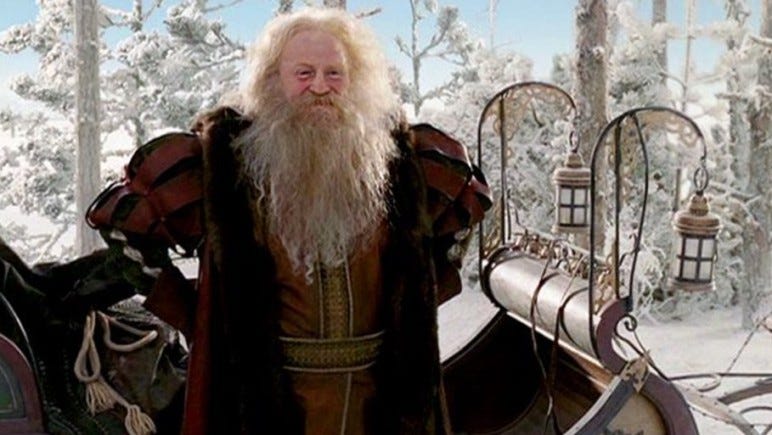And he said, What hast thou done? the voice of thy brother’s blood crieth unto me from the ground.
And now art thou cursed from the earth, which hath opened her mouth to receive thy brother’s blood from thy hand;
When thou tillest the ground, it shall not henceforth yield unto thee her strength; a fugitive and a vagabond shalt thou be in the earth. (Genesis 4:10-12, KJV)
As C. S. Lewis’ The Lion, the Witch and the Wardrobe (1950) opens, the land of Narnia is under a curse. The Narnian forest lies frozen under a blanket of snow and it is “always winter, and never Christmas.” It is a land of stifled life and gloom.
The curse is a spell cast by Jadis, the self-proclaimed Queen of Narnia. To the woodland creatures who make up the resistance to her illegitimate tyranny, she is called the White Witch. Jadis cannot create or celebrate anything real: her power is purely negative; illusions and domination – sound familiar? The ultimate hope of the resistance lies in the return of the lion Aslan (his name in Narnia, though he is called other things in other worlds), the true King and creator of universes (there are many universes in The Chronicles of Narnia, connected by various portals that allow for travel between them; Aslan initially sang them into being).
Lewis presents Jadis along the lines of a modern day totalitarian dictator: she governs through fear, has spies everywhere, and employs a Secret Police force. She exerts power by corrupting the true natures of the various creatures of Narnia. Against her is an insurgency of the truehearted woodland creatures, like the fauns (satyrs), beavers, most of the birds and trees, and other critters, and eventually the sons and daughters of Adam and Eve, the humans, travelers from Earth, the Pevensie children: Peter, Susan, Edmund, and Lucy.
Here I would like to focus on the relatively small, but significant, role of Father Christmas in the larger drama of liberation which will involve the breaking of curses, the deployment of deep magic from the beginning of time, and the even deeper magic from before the dawning of time.
The eventual advent of Father Christmas is foreshadowed by the appearance of his antitype early in the story. On Edmund’s first journey to Narnia, he has an encounter with Jadis. She travels in a sled pulled by reindeer “about the size of Shetland ponies” (Father Christmas’ reindeer are much larger) driven by “a fat dwarf” who wears “a red hood” and has “a huge beard.”
In Clement Clarke Moore’s classic poem, ‘Twas the Night Before Christmas (1823), Santa is portrayed as “a right jolly old elf.” In Germanic folklore, elves and dwarves have some things in common, but, though the evidence is mixed in the early Eddas, dwarves are, if not grasping, at least reluctant to share or even trade their objects of finely crafted metalwork. Plus, they live underground which is not as cool as living amongst the forests and glens as elves do. So, Jadis is driven around by a stubby, selfish, little Santa antitype. With her being drawn behind in the sleigh, this little guy is a harbinger of malevolence and despair.
Father Christmas arrives in Narnia slightly more than halfway through the book. He drives a sledge pulled by impressive reindeer, he is “a huge man in a bright red robe (bright as hollyberries) with a hood that had fur inside it and a great white beard that fell like a foamy waterfall over his chest.” Here is the real thing. Finally, though it is still winter in Narnia, it is also Christmas!
He explains: “’I’ve come at last… She [Jadis] has kept me out for a long time, but I have got in at last. Aslan is on the move. The Witch’s magic is weakening.’” Now that he has finally gained access to this world, what does he set about to do? Well, to distribute presents of course! We all love presents.
What does he bring for Narnians still under occupation? For Mrs. Beaver a new sewing machine and for Mr. Beaver he completes his dam and adds a really nice sluice-gate! For the Pevensie children? For Peter, a sword and shield. Susan gets a bow that “does not easily miss” and a horn for sounding alarms. Little Lucy gets a small dagger and bottle of healing elixir (Edmund, at this point, is a captive of the White Witch, so no gifts for him). Santa is an arms supplier to the Resistance! You really have to love Lewis and ‘classic’ children’s stories.
There is the dawning of hope for The Creatures’ Liberation Front of Narnia (my term, not Lewis’s). Christmas has come, which brings with it the promise of new life and liberation from the darkness.
So, when you see Santa, or Father Christmas, or whatever he is called in your neck of the woods, give him “a wink of the eye and twist of the head” (a secret signal of the Resistance) and know he is on our side. Long live Father Christmas! Long live Christmas! Long live Aslan! Long live Narnia!
This essay was first published on Winter Oak.








Now you are giving us a real Christmas Gift, Peace be with you.
I've never heard C.S. Lewis's classic tale presented in that manner... How Wonderfully Delightful! You've resurrected it as a tale of wondrous and magical hopefulness for adults... or perhaps only for grownups that still have hopeful anticipation in their eyes for a better tomorrow... regardless... It made me feel good just reading it... Well Done, Sir! Kudos and Golf Claps for that one!